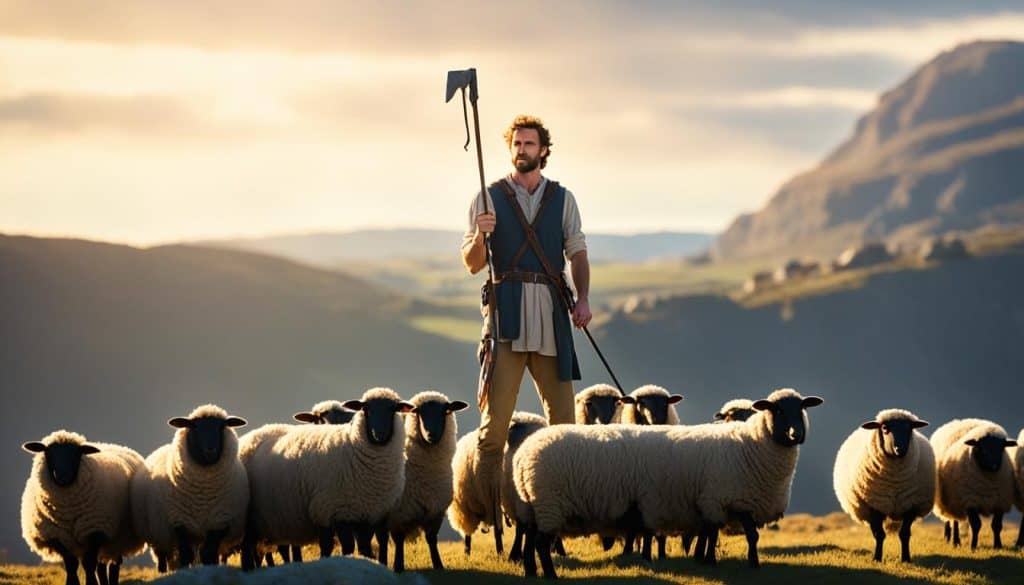Table of Contents
Have you ever wondered about the origin stories of these important Bible characters? Did they start as powerful leaders or from humble beginnings? Today, let’s look into the lives of biblical figures who were shepherds.
In Genesis, we read about the first shepherd. A future king of Israel also started by watching his father’s sheep. These experiences with sheep greatly affected their lives. So, what did being a shepherd really teach them?
We will explore the stories of Abel, Jacob, Moses, David, and the shepherds from the nativity scene. We’ll look at their simple starts, the hurdles they overcame, and the special meaning of being shepherds in their stories. Find out how being shepherds made them the people we remember today and helped write the Bible.
Abel: The First Shepherd
Abel was the second son of Adam and Eve, highlighted in Genesis. He is known as the first shepherd. Genesis 4:2 tells us he was different from his brother Cain, who farmed.
Being the first shepherd shows how important it was to care for sheep in those times. It was not just for food. It was also seen as leading and guiding. Abel showed his deep connection to nature. He took care of the sheep he was responsible for.
Abel’s Offering and Tragic Fate
In Genesis, Abel proves his dedication through his gift to God. He gave God the firstborn from his flock. This was seen as a pure and precious gift. God liked Abel’s offering because it showed his true devotion.
“The Lord looked with favor on Abel and his offering.” – Genesis 4:4
Conversely, God did not like the gift Cain offered, which was from his crops. This made Cain very jealous and led him to kill Abel.
| Abel: The First Shepherd | |
|---|---|
| Date | Early biblical times |
| Occupation | Shepherd |
| Notable Deeds | Presented a valuable and pure offering to God |
| Legacy | Symbolizes devotion, righteousness, and martyrdom |
Abel’s story teaches us to offer our best to God sincerely. As the first shepherd, he highlights the spiritual duty of leaders to protect and guide their people.
Jacob: Shepherd of the Twelve Tribes of Israel
Jacob was key in biblical history, leading the twelve tribes of Israel. He started as a shepherd for his uncle Laban, looking after flocks. His story, found in Genesis 30:31-43, shows how this shaped him as the tribes’ father.
Being a shepherd taught Jacob about responsibility, patience, and care. These skills helped him later as a leader. He learned quick decision-making and how to use resources well. This helped a lot in his leadership role.
Genesis 30:31-43 tells the tale of Jacob’s plan with Laban. Jacob’s strategy made his flock stronger with speckled and spotted sheep. Miraculously, his plan succeeded, boosting his wealth.
“So the man (Jacob) became exceedingly prosperous and came to own large flocks, and female and male servants, and camels and donkeys.”
Jacob’s success wasn’t just luck. It showed his wit and hard work. His experience caring for sheep set the stage for leading Israel’s tribes. He was known for thinking ahead, solving problems, and adapting, which greatly helped Israel grow.
Meditating on Jacob’s start as a shepherd tells us something important. Great leaders like Jacob can come from anywhere. His time with sheep built his character for leading a nation. This story encourages us to learn from every experience.
The Influence of Jacob’s Shepherd Experience:
Being a shepherd greatly influenced Jacob’s character. It readied him for leading Israel’s twelve tribes:
- He learned about responsibility and being reliable from tending to sheep.
- Caring for sheep taught him the value of patience, vital for leading a people.
- His deep care for the flock showed his true concern for their well-being.
- Handling challenges with the flocks built his strategic thinking capabilities. This helped him in leading Israel.
This summary shows how Jacob’s quality as a shepherd influenced his leadership:
| Qualities | Influence on Jacob |
|---|---|
| Responsibility | Prepared Jacob for the weight of leading a nation, ensuring he was accountable to his people. |
| Patience | Equipped Jacob with the ability to persevere through challenges, allowing for long-term vision and sustainable leadership. |
| Care | Fostered empathy in Jacob, enabling him to connect with and understand the needs of his people. |
| Strategic Thinking | Empowered Jacob to make wise decisions and navigate complexity, leading to the growth and success of Israel. |
Jacob’s shepherd experience readied him for exceptional leadership. His early work with flocks was foundational for his later success.

Moses: From Shepherd to Leader
Moses is highly respected in biblical history. His journey is inspiring, going from a shepherd to leading the Israelites. He shows us the power of strength, determination, and guidance from above.
He ran from Egypt’s Pharaoh, finding safety in Midian. Here, he became a shepherd for Jethro, his father-in-law. This unexpected job equipped him for leading the Israelites out of Egypt.
” Now Moses was tending the flock of Jethro his father-in-law, the priest of Midian, and he led the flock to the far side of the wilderness and came to Horeb, the mountain of God.”
While shepherding, Moses saw a bush burning but not consumed. This was a turning point. God spoke to him, telling him to free the Israelites. With some fear but great humility, Moses accepted. He decided to approach Pharaoh and ask for freedom for his people.
Moses faced many trials, including Pharaoh’s stubbornness and Israelites’ doubt. Despite this, his trust in God never wavered. Along with many wonders, he brought his people through the Red Sea to the wilderness. He was leading them towards the land God promised.
“The Lord will fight for you, and you shall hold your peace.”
From his humble beginnings as a shepherd, Moses learned key traits. These included patience, leadership, and care for those he led. His faith and obedience were crucial. They not only won freedom for the Israelites but also made him a lasting figure of hope.
Moses’ story underlines that even from the lowest places, great things can rise. His commitment to God and his people marked an incredible journey. He turned from a shepherd into a leader, showing the might of faith in action for all time.
David: The Shepherding King
David’s story began as a young shepherd in the Bible. Even then, he was not ordinary. He bravely fought off lions and bears attacking his father’s sheep.
In 1 Samuel 17:34-37, David faced these beasts without fear. He rescued his flock from danger. This act showed his courage and deep care for others early on.
“Your servant has killed both the lion and the bear; this uncircumcised Philistine will be like one of them, because he has defied the armies of the living God.”
Being a shepherd shaped David into a leader. He learned to look after his sheep with devotion. These skills would later make him a great king, protecting his people.
David went from a simple shepherd to a powerful king. His journey teaches us about using humble beginnings for great things. It’s a story of faith, courage, and leading with a kind heart.

| David: The Shepherding King | |
|---|---|
| Date | 10th century BC |
| Occupation | Shepherd, Musician, Warrior, King |
| Significance | His reign marked a golden era for the nation of Israel, and his Psalms are cherished as expressions of faith and worship. |
The Shepherds at the Nativity
In the Bible, when Jesus was born, shepherds were nearby. The Gospel of Luke tells us about this special event. Shepherds were watching their sheep near Bethlehem when an angel appeared to them.
The angel’s bright light scared the shepherds at first. But then, the angel said not to be afraid. It told them about the birth of Jesus, the Savior, in Bethlehem. The angel shared the good news, bringing great joy.
This news excited the shepherds. The angel told them they’d find Jesus wrapped in cloths, laying in a manger.
“Fear not, for behold, I bring you good news of great joy that will be for all the people.”
When the shepherds saw Jesus, they were amazed. They realized it was just as the prophecies had said. They left, spreading the good news everywhere.
The people they told were amazed. They couldn’t believe the shepherds’ story about the angels and the Savior.
The story reminds us that God welcomes everyone. The angel’s message was for all, including these simple shepherds. They were the first to know about Jesus’ birth, showing God’s love for everyone.
The shepherds’ story still matters today. Jesus’ birth fills us with hope and joy. Even now, people all over the world find inspiration in this story.
The shepherds’ story teaches us a lot. They were simple people, yet they were chosen to see the Savior first. This shows God’s love is open to all, no matter who we are.

We should learn from the shepherds. They trusted and shared the good news. Let’s also find joy and hope in Jesus’ birth. Let his love brighten our lives.
Conclusion
The biblical shepherds set a prime example for us. They started small and made big impacts. Their work with sheep shaped them for important religious roles.
Able from Genesis showed his worth, like many other shepherds. Jacob became the father of twelve tribes after tending to his flock. Moses kept the sheep before freeing his people from Egypt.
David became the brave king of Israel after protecting his father’s sheep. The shepherds present at Jesus’ birth in Luke’s Gospel show humility’s power. They were among the first to know about the Messiah.
The lesson here is clear: our early experiences don’t define us. They prepare us for important things. Let these shepherd tales motivate you. Even small starts can lead to amazing results.




